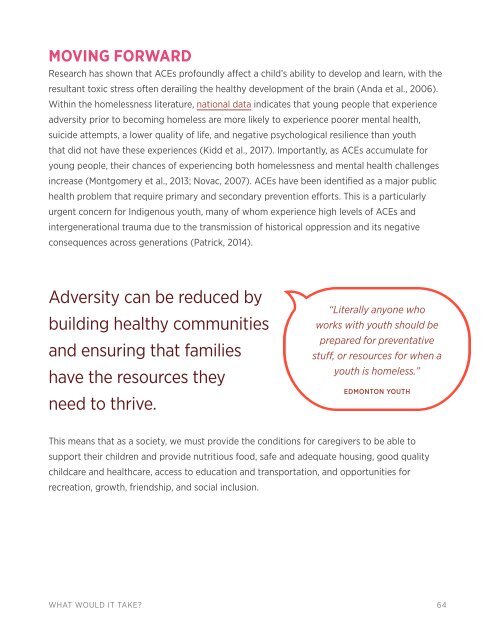COH-AWH-What_Would_it_Take
Create successful ePaper yourself
Turn your PDF publications into a flip-book with our unique Google optimized e-Paper software.
MOVING FORWARD<br />
Research has shown that ACEs profoundly affect a child’s abil<strong>it</strong>y to develop and learn, w<strong>it</strong>h the<br />
resultant toxic stress often derailing the healthy development of the brain (Anda et al., 2006).<br />
W<strong>it</strong>hin the homelessness l<strong>it</strong>erature, national data indicates that young people that experience<br />
advers<strong>it</strong>y prior to becoming homeless are more likely to experience poorer mental health,<br />
suicide attempts, a lower qual<strong>it</strong>y of life, and negative psychological resilience than youth<br />
that did not have these experiences (Kidd et al., 2017). Importantly, as ACEs accumulate for<br />
young people, their chances of experiencing both homelessness and mental health challenges<br />
increase (Montgomery et al., 2013; Novac, 2007). ACEs have been identified as a major public<br />
health problem that require primary and secondary prevention efforts. This is a particularly<br />
urgent concern for Indigenous youth, many of whom experience high levels of ACEs and<br />
intergenerational trauma due to the transmission of historical oppression and <strong>it</strong>s negative<br />
consequences across generations (Patrick, 2014).<br />
Advers<strong>it</strong>y can be reduced by<br />
building healthy commun<strong>it</strong>ies<br />
and ensuring that families<br />
have the resources they<br />
need to thrive.<br />
“L<strong>it</strong>erally anyone who<br />
works w<strong>it</strong>h youth should be<br />
prepared for preventative<br />
stuff, or resources for when a<br />
youth is homeless.”<br />
EDMONTON YOUTH<br />
This means that as a society, we must provide the cond<strong>it</strong>ions for caregivers to be able to<br />
support their children and provide nutr<strong>it</strong>ious food, safe and adequate housing, good qual<strong>it</strong>y<br />
childcare and healthcare, access to education and transportation, and opportun<strong>it</strong>ies for<br />
recreation, growth, friendship, and social inclusion.<br />
WHAT WOULD IT TAKE? 64
















